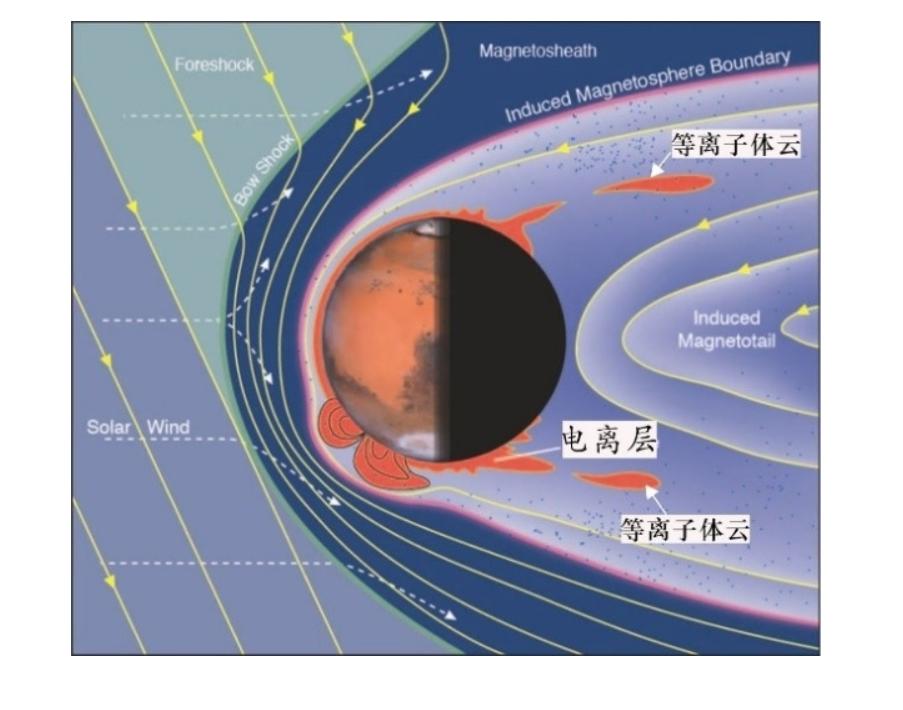IT House news on February 12, according to the Institute of Geology and Geophysics of the Chinese Academy of Sciences, Mars atmospheric escape is the core scientific problem of Mars exploration. Exploring the escape of the Martian atmosphere helps to explain the evolution of the global climate environment on Mars.
Studies have shown that the solar wind is one of the most effective drivers of particle escape from the Martian atmosphere. This is due to the fact that Mars does not have a global magnetic field, and the solar wind can interact directly with the Martian ionosphere or atmospheric ions, and continuously erode through electromagnetic forces, accelerating the escape of atmospheric ions into interplanetary space.
Early observations have shown that the solar wind interacts with the Martian ionosphere to drive or strip large clumps of Martian ionospheric ions (e.g., O+, O2+) to form "plasma clouds" that escape explosively and integrally (Figure 1). However, due to the observation altitude of the spacecraft and the detection performance of the instrument, little is known about the formation and evolution mechanism of the "plasma cloud", especially the low-altitude "plasma cloud".

To this end, using data observations from a variety of high-performance scientific exploration instruments carried by the MAVEN Mars rover in the United States, Zhang Chi, a doctoral candidate at the Institute of Geology and Geophysics of the Chinese Academy of Sciences, and researchers Rong Zhaojin and Wei Yong, as well as the Swedish Institute of Space Physics, the Max Planck Institute of Solar System Research in Germany, and the University of California, Berkeley, have discovered and reported for the first time the periodic plasma cloud structure observed in the low altitude (600 km) range of Mars (Figure 2).
Unlike previous studies, this periodic low-altitude "plasma cloud" structure reveals a new set of observational features: the ion spectroscopy exhibits dispersion characteristics (high-energy ions can be observed earlier), different Martian ion compositions have roughly the same velocity, and the emergence of plasma clouds is accompanied by an increase in total magnetic field, and strong solar wind electron settlement characteristics. The analysis results showed that these plasma clouds originated in the low-altitude ionospheric region (~120 km height) and escaped along the tail of the open magnetic field line. At the same time, estimates show that the "plasma cloud" in this event can significantly improve the escape rate of ions in the Martian atmosphere. This suggests that "plasma clouds" are the primary way for ions in the Martian atmosphere to escape.
Based on these observational features, as shown in Figure 3, the study proposes that the possible mechanisms for the formation of "plasma clouds" should be:
The periodic solar wind compresses the Martian magnetosphere, inducing periodic geomagnetic field reconnection between the solar wind magnetic field and the Martian crust magnetic field, and the magnetic field reconnection produces open magnetic field lines and settled solar wind plasma, and the settled solar wind plasma heats the low-altitude ionospheric plasma, so that these low-altitude plasmas periodically escape outward.
The study is the first to report the low-altitude plasma cloud structure of Mars and proposes the physical mechanisms of its possible generation, which is of great scientific significance for understanding the escape of Martian ions and the interaction of the solar wind with Mars, and provides an important guidance for the subsequent analysis of the mars exploration data of the mainland "Tianwen-1".
IT House understands that the research is published in The Astrophysical Journal Letters.